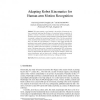21 search results - page 3 / 5 » Speed adaptation for a robot walking with a human |
KES
2007
Springer
13 years 8 months ago
2007
Springer
Abstract. This paper presents a novel method to the analysis of human-arm motion, in particular improving the efficiency of conventional motion recognition algorithms. Contrary to...
ROBOCUP
2009
Springer
14 years 1 months ago
2009
Springer
In this article a hand gesture recognition system that allows interacting with a service robot, in dynamic environments and in real-time, is proposed. The system detects hands and ...
DAGM
2009
Springer
14 years 3 months ago
2009
Springer
High-speed smooth and accurate visual tracking of objects in arbitrary, unstructured environments is essential for robotics and human motion analysis. However, building a system th...
ICRA
2009
IEEE
14 years 3 months ago
2009
IEEE
— Humans and animals adapt their leg impedance during running for both internal(e.g. loading) and external(e.g. surface) changes. In this paper we examine the relationship betwee...
IJRR
2006
13 years 8 months ago
2006
The first functional load-carrying and energetically autonomous exoskeleton was demonstrated at U.C. Berkeley, walking at the average speed of 0.9 m/s (2 mph) while carrying a 34 ...

